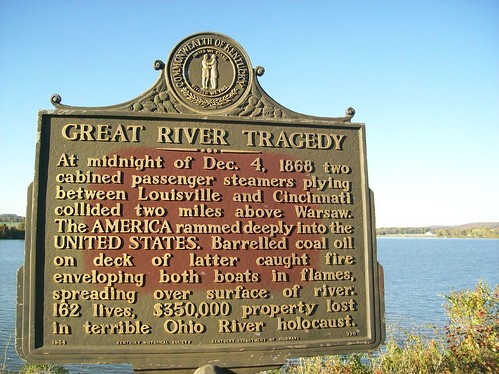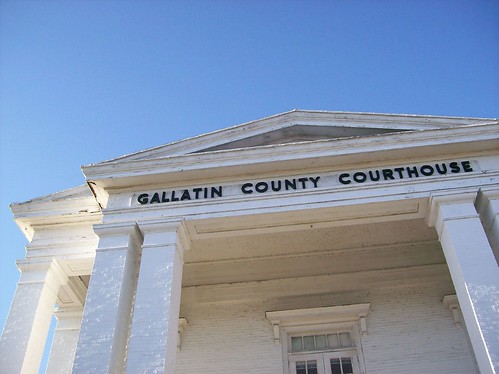
Great River Tragedy
Kentucky Historical Marker 0720
At midnight of Dec. 4, 1868 two cabined passenger steamers plying between Louisville and Cincinnati collided two miles above Warsaw. The America rammed deeply into the United States. Barrelled coal oil on deck of latter caught fire enveloping both boats in flames, spreading over surface of river. 162 lives, $350,000 property lost in terrible Ohio River holocaust.There is no historical marker that I have seen more in my life than this one. I remember passing it every morning on my way to my elementary school. It is only one of three markers in Gallatin county and also, as far as I know, the biggest thing to ever occur in Kentucky's smallest county (98.81 square miles).

Tidbit: This is the longest continually in use courthouse in all of Kentucky.
So, here's the story. On the night of Dec. 4, 1868, a steamboat named America collided with its sister ship, the United States. They were on the Ohio River, between the banks of Indiana and two miles to the north of Warsaw, Kentucky, the seat of Gallatin County.
 |
The closest home to the wreck was a half mile away on the Indiana side. Mr. Rahl, who owned the home, tried to help those stranded as much as he could. Fortunately, another boat made its way to the collision a couple of hours later and ferried the survivors to Warsaw were the citizens there took it upon themselves to help as much as possible.
The most famous passenger was Ole Bull (a very interesting fellow). Ole Bull was a famous Norwegian violinist and composer. Before he escaped the America, he made sure he had his violin and only then swam to shore. Reading a few of the crazy tidbits about him I would not be surprised if he was playing the violin while floating on his back to shore.
Although the historical marker seems to indicate that 162 people died from the boats, other sources I have checked seem to show around 80 actually perished. I am not sure if the Historical Society has information I cannot find or perhaps there was a typo and it represents the total number of passengers on the ships.
If this were a book I was reading and not a real event, I would be upset at the obvious symbolism of a boat named the America crashing into a boat named the United States near Kentucky, a state caught in the middle between the The South and The North in a post-Civil War country.
Being that it is real, all I can say is "wow."
See? History is always more surprising than anything you can imagine.
 |

No comments:
Post a Comment